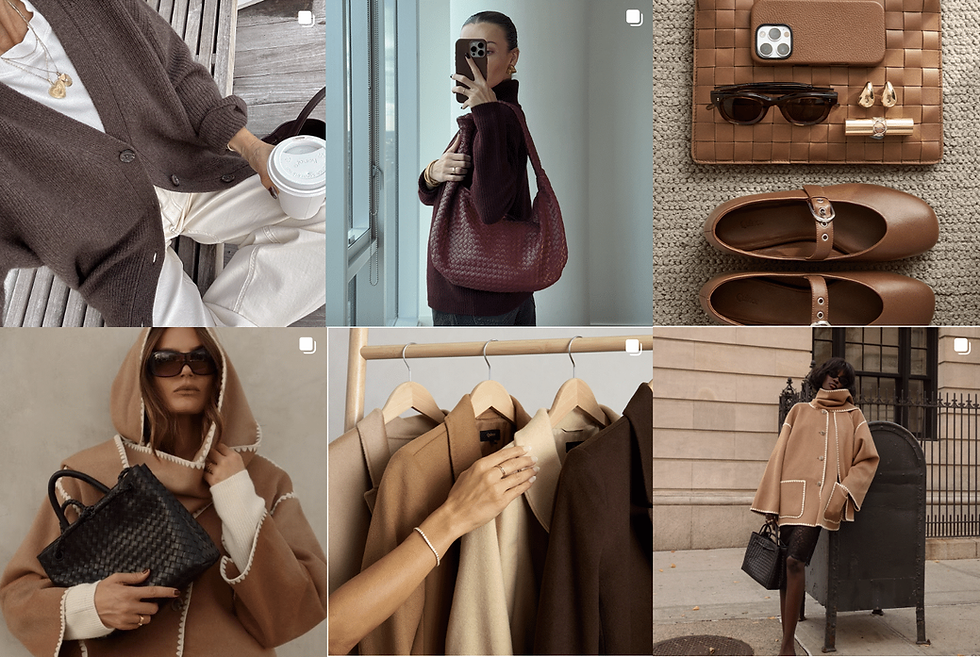Insight of the Day: If Consumers Love Logos, What is Driving Demand for Dupes?
- InsightTrendsWorld
- Feb 5
- 4 min read
Why It’s Trending
The demand for dupes (affordable replicas of high-end products) is surging, driven by economic uncertainties, rising luxury prices, and shifting consumer attitudes, particularly among younger generations. This trend highlights a growing disconnect between traditional luxury brand strategies—such as heritage marketing—and the priorities of modern consumers.
Overview
Consumers are increasingly seeking affordable alternatives to luxury goods, as evidenced by the success of companies like Quince, which offers high-quality dupes of popular designer items. This trend is fueled by economic pressures, dissatisfaction with luxury pricing, and a lack of brand loyalty among younger shoppers. Additionally, luxury brands’ reliance on heritage and logos as selling points is losing its appeal for many consumers, particularly Gen Z.
Detailed Findings
Economic Factors: Rising luxury prices and economic uncertainties are causing consumers, especially younger ones, to prioritize affordability over brand prestige.
Quality Concerns: Some consumers feel that luxury price increases are not justified by improvements in product quality.
Ethical Backlash: Reports of poor working conditions in luxury supply chains (e.g., Armani, Dior) have tarnished brand reputations.
Heritage Fatigue: Younger consumers are less influenced by luxury brands’ heritage and craftsmanship narratives, which were once key selling points.
Lack of Loyalty: Gen Z consumers are less loyal to brands and more willing to switch to dupes for a better deal, as long as the look and feel of the product are similar.
Key Takeaway
The rise of dupes reflects a shift in consumer priorities, with affordability, ethical concerns, and aesthetics outweighing traditional luxury brand appeals like heritage and logos. This poses a significant challenge for luxury brands, particularly in retaining younger consumers.
Main Trend
Name: "The Dupe Revolution"Description: Consumers, especially younger generations, are prioritizing affordability, ethical considerations, and aesthetics over traditional luxury brand appeals like heritage and logos, driving the demand for dupes.
Consumer Motivation
Affordability: Consumers want high-quality products at lower prices.
Ethical Concerns: Growing awareness of unethical practices in luxury supply chains is pushing consumers toward alternatives.
Aesthetic Appeal: The look and feel of a product are often more important than the brand behind it.
Lack of Loyalty: Younger consumers are less attached to brands and more willing to explore alternatives.
What’s Driving the Trend
Economic Pressures: Rising luxury prices and economic uncertainties are making dupes more appealing.
Ethical Backlash: Reports of poor working conditions in luxury supply chains are eroding trust in traditional brands.
Generational Shifts: Younger consumers prioritize affordability and aesthetics over heritage and brand loyalty.
Motivation Beyond the Trend
Empowerment: Consumers feel empowered to make informed choices that align with their values and budgets.
Accessibility: Dupes make luxury aesthetics accessible to a broader audience.
Description of Consumers
Age: Primarily younger consumers, including Millennials and Gen Z.
Gender: Gender-neutral, though trends may vary by product category.
Income: Middle-income consumers seeking affordable alternatives to luxury goods.
Lifestyle: Urban, digitally connected, and value-conscious, with a focus on aesthetics and ethical consumption.
Conclusions
The demand for dupes highlights a shift in consumer priorities, with affordability, ethics, and aesthetics taking precedence over traditional luxury brand appeals. This trend poses a significant challenge for luxury brands, particularly in retaining younger consumers.
Implications
For Brands: Luxury brands must rethink their strategies to address affordability, ethical concerns, and shifting consumer priorities.
For Society: The rise of dupes reflects broader societal shifts toward ethical consumption and accessibility.
For Consumers: Consumers gain access to affordable, high-quality alternatives that align with their values and budgets.
For the Future: The luxury market may need to adapt to a new reality where heritage and logos are no longer primary drivers of consumer loyalty.
Consumer Trend
Name: "The Dupe Revolution"Description: Consumers are prioritizing affordability, ethical considerations, and aesthetics over traditional luxury brand appeals, driving the demand for dupes.
Consumer Sub-Trend
Name: "Ethical Aesthetics"Description: A growing preference for products that combine ethical production practices with desirable aesthetics, even if they are not from traditional luxury brands.
Big Social Trend
Name: "Affordable Luxury"Description: A shift toward making luxury aesthetics accessible to a broader audience through affordable alternatives.
Worldwide Social Trend
Name: "Ethical Consumerism"Description: A global movement toward ethical consumption, where consumers prioritize brands that align with their values.
Social Drive
Name: "Empowerment Through Choice"Description: Consumers are driven by the desire to make informed choices that align with their values, budgets, and aesthetic preferences.
Learnings for Brands in 2025
Address Affordability: Offer more accessible price points or value-driven products.
Emphasize Ethics: Highlight ethical practices and transparency in supply chains.
Rethink Heritage: Focus on modern narratives that resonate with younger consumers.
Leverage Aesthetics: Prioritize design and aesthetics to compete with dupes.
Strategy Recommendations for Brands in 2025
Introduce Affordable Lines: Create sub-brands or product lines that cater to budget-conscious consumers.
Enhance Transparency: Communicate ethical practices and sustainability efforts clearly.
Engage Younger Consumers: Use social media and influencer partnerships to connect with Gen Z and Millennials.
Focus on Design: Invest in innovative, trend-driven designs that appeal to aesthetic-focused consumers.
Final Sentence
The "Dupe Revolution" underscores the need for luxury brands to adapt to shifting consumer priorities, focusing on affordability, ethics, and aesthetics to remain relevant in 2025 and beyond.
Final Note
Core Trend: "The Dupe Revolution" – Consumers are prioritizing affordability, ethics, and aesthetics over traditional luxury brand appeals.
Core Strategy: "Modern Luxury" – Rethinking luxury strategies to address affordability, ethical concerns, and shifting consumer priorities.
Core Industry Trend: "Affordable Aesthetics" – Making luxury aesthetics accessible through affordable, high-quality alternatives.
Core Consumer Motivation: "Empowerment Through Choice" – Consumers are driven by the desire to make informed choices that align with their values and budgets.
Final Conclusion
To thrive in 2025, luxury brands must embrace the "Dupe Revolution" by addressing affordability, ethical concerns, and shifting consumer priorities. By focusing on modern narratives, ethical practices, and innovative designs, brands can retain relevance and appeal to younger, value-conscious consumers.
New chat

Comments